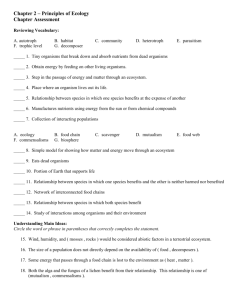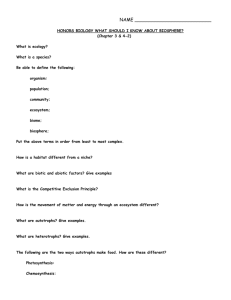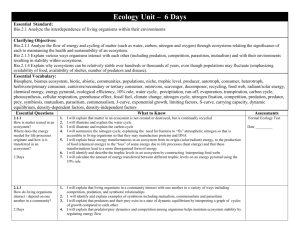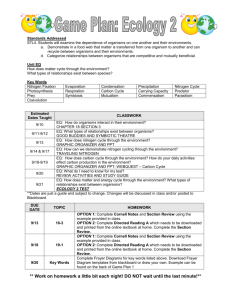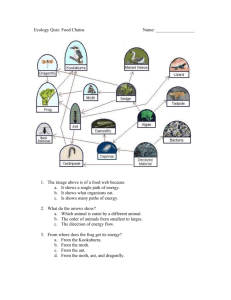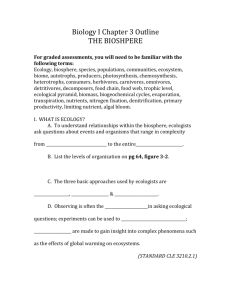Ecology Test 1 Review - Kenton County Schools
advertisement
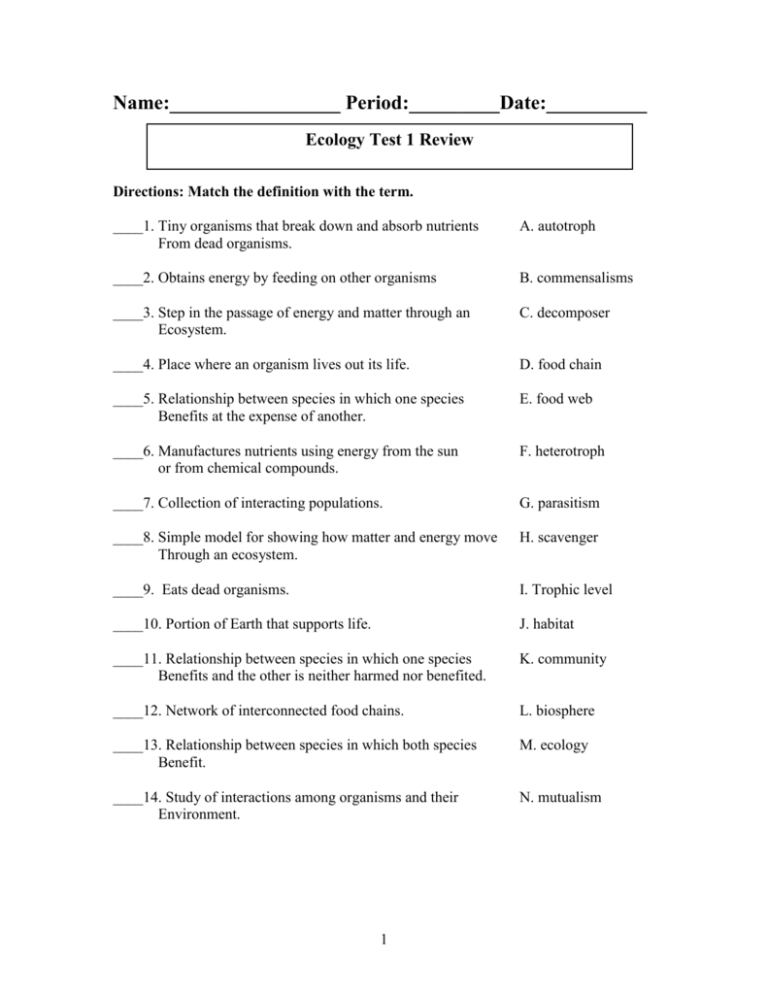
Name:_________________ Period:_________Date:__________ Ecology Test 1 Review Directions: Match the definition with the term. ____1. Tiny organisms that break down and absorb nutrients From dead organisms. A. autotroph ____2. Obtains energy by feeding on other organisms B. commensalisms ____3. Step in the passage of energy and matter through an Ecosystem. C. decomposer ____4. Place where an organism lives out its life. D. food chain ____5. Relationship between species in which one species Benefits at the expense of another. E. food web ____6. Manufactures nutrients using energy from the sun or from chemical compounds. F. heterotroph ____7. Collection of interacting populations. G. parasitism ____8. Simple model for showing how matter and energy move Through an ecosystem. H. scavenger ____9. Eats dead organisms. I. Trophic level ____10. Portion of Earth that supports life. J. habitat ____11. Relationship between species in which one species Benefits and the other is neither harmed nor benefited. K. community ____12. Network of interconnected food chains. L. biosphere ____13. Relationship between species in which both species Benefit. M. ecology ____14. Study of interactions among organisms and their Environment. N. mutualism 1 Directions: In the space at the left, write the word or phrase in parentheses that correctly completes the statement. _____________________ 15. Wind, humidity, and (mosses, rocks) would be considered Abiotic factors in a terrestrial ecosystem. ______________________16. The size of a population does not directly depend on the Availability of (food, decomposers). ______________________17. To show how the weight of living material at each trophic Level of a food chain changes, you could use a pyramid of (numbers, biomass). _____________________18. In the nitrogen cycle, bacteria and (lightning, decomposers) Convert atmospheric nitrogen into nitrogen compounds Usable by plants. _____________________19. Some energy that passes through a food chain is lost to the Environment as (heat, matter). _____________________20. Carbon and nitrogen are released back into the atmosphere During (symbiosis, decomposition). _____________________21. Carbon and nitrogen are released back into the atmosphere During (symbiosis, decomposition). _____________________22. Both the alga and the fungus of a lichen benefit from their Relationship. This relationship is one of (mutualism, commensalisms). Directions: In the space at the left, write the word or phrase that includes all the rest. ____________________23. Trophic level, food web, food chain ____________________24. parasitism, commensalisms, mutualism, symbiosis ____________________25. organism, ecosystem, population, community ____________________26. ecosystems, biotic factors, biosphere, abiotic factors ____________________27. omnivores, consumers, carnivores, herbivores, scavengers, decomposers ____________________28. evaporation, precipitation, water cycle, condensation, urination 2 Directions: Questions 28-32 refer to the food chain pictured below. In the space at the left, write the letter of the word or phrase that best completes the statement or answers the question. __29. Energy flows from A. coyotes to grasses C. mice to cats B. cats to mice D. coyotes to cats __30. The coyotes are A. herbivores B. third-oder heterotrophs C. second-order heterotrophs D. decomposers __31. How many trophic levels does the food chain include? A. four B. one C. three D. two __32. As matter and energy move from grasses to coyotes, the amount of available energy A. always decreases and population size always increases B. always increases and population size always decreases C. always decreases but population size may increase or decrease D. increases or decreases but population size remains the same __33. Suppose 10,000 units of energy are available at the level of the grasses. What is the total number of energy units lost by the time energy reaches the coyote? A. 90 B. 9990 C. 900 D. 9999 __34. Energy that is lost at each trophic level of an ecosystem is replenished by A. heat B. Nutrients C. sunlight D. organisms 3 __35. Besides energy, what moves through the organisms at each trophic level of an ecosystem? A. Organisms B. Nutrients C. Sunlight D. cycles __36. Evaporation and condensation are part of the A. carbon cycle B. nitrogen cycle C. phosphorus cycle D. water cycle __37. Plants lose water to the air through A. transpiration B. photosynthesis C. their roots D. evaporation __38. Animals lose water when they A breath in B. urinate C. breath out D. both B and C __39. The water in the atmosphere is returned to the earth by A. precipitation B. evaporation C. photosynthesis D. Decomposition __40.Autotrophs and heterotrophs use carbon molecules for energy and A. photosynthesis B. evaporation C. decomposition D. both a and b __41. Heterotrophs get carbon molecules by A. making the molecules themselves C. decaying B. feeding on other organisms D. growing __42. When decomposers break down the carbon molecules in dead organisms, A. the dead organisms are converted to coal B. oxygen is released C. carbon dioxide is released D. carbon dioxide is converted to energy-rich carbon molecules __43. Fertilizers provide plants with A. nitrogen B. carbon C. water D. oxygen __44. Which of the following convert(s) nitrogen in the air into a form plants can use? A. bacteria B. lightning C. sunlight D. both a and b. __45. Plants use nitrogen to make A. carbohydrates B. decomposes C. proteins D. both b and c __46. An animal returns nitrogen to the environment when it A. breathes B. decomposes C. urinates D. both b and c 4 Directions: Answer the following questions completely. 47. Compare and contrast populations and communities. 48. A leaf-eating caterpillar turns into a nectar-eating butterfly. How is this feeding behavior an advantage for this species? 49. Clownfish are small, tropical marine fish usually found swimming among stringing tentacles of sea anemones. What type of symbiotic relationship do these animals have if the clownfish are protected by the sea anemone, but the anemone does not benefit from the clownfish? 50. Give an example and describe a parasitic and mutualistic relationship. 51. Why do autotrophs always occupy the lowest level of ecological pyramids? 52. Describe the difference between a food chain and a food web. ( not just the definition) 53. The country of Avorare has many starving people. Should you encourage the people to grow crops such as vegetables, wheat, and corn, or is it better to encourage them to use the land to raise cattle for beef? Explain your answer. 5


